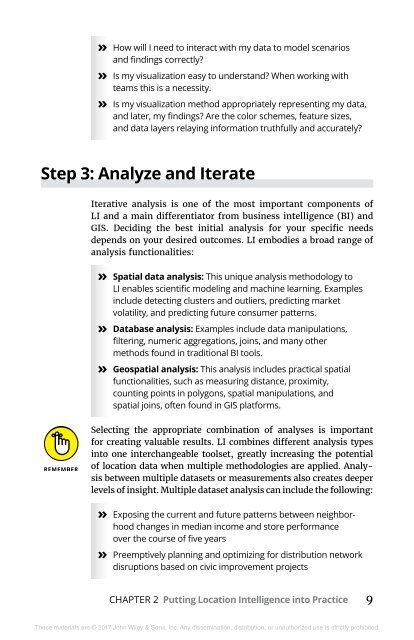Location-Intelligence-For-Dummies-ebook
You also want an ePaper? Increase the reach of your titles
YUMPU automatically turns print PDFs into web optimized ePapers that Google loves.
»»<br />
How will I need to interact with my data to model scenarios<br />
and findings correctly?<br />
»»<br />
Is my visualization easy to understand? When working with<br />
teams this is a necessity.<br />
»»<br />
Is my visualization method appropriately representing my data,<br />
and later, my findings? Are the color schemes, feature sizes,<br />
and data layers relaying information truthfully and accurately?<br />
Step 3: Analyze and Iterate<br />
Iterative analysis is one of the most important components of<br />
LI and a main differentiator from business intelligence (BI) and<br />
GIS. Deciding the best initial analysis for your specific needs<br />
depends on your desired outcomes. LI embodies a broad range of<br />
analysis functionalities:<br />
»»<br />
Spatial data analysis: This unique analysis methodology to<br />
LI enables scientific modeling and machine learning. Examples<br />
include detecting clusters and outliers, predicting market<br />
volatility, and predicting future consumer patterns.<br />
»»<br />
Database analysis: Examples include data manipulations,<br />
filtering, numeric aggregations, joins, and many other<br />
methods found in traditional BI tools.<br />
»»<br />
Geospatial analysis: This analysis includes practical spatial<br />
functionalities, such as measuring distance, proximity,<br />
counting points in polygons, spatial manipulations, and<br />
spatial joins, often found in GIS platforms.<br />
Selecting the appropriate combination of analyses is important<br />
for creating valuable results. LI combines different analysis types<br />
into one interchangeable toolset, greatly increasing the potential<br />
of location data when multiple methodologies are applied. Analysis<br />
between multiple datasets or measurements also creates deeper<br />
levels of insight. Multiple dataset analysis can include the following:<br />
»»<br />
Exposing the current and future patterns between neighborhood<br />
changes in median income and store performance<br />
over the course of five years<br />
»<br />
» Preemptively planning and optimizing for distribution network<br />
disruptions based on civic improvement projects<br />
CHAPTER 2 Putting <strong>Location</strong> <strong>Intelligence</strong> into Practice 9<br />
These materials are © 2017 John Wiley & Sons, Inc. Any dissemination, distribution, or unauthorized use is strictly prohibited.


